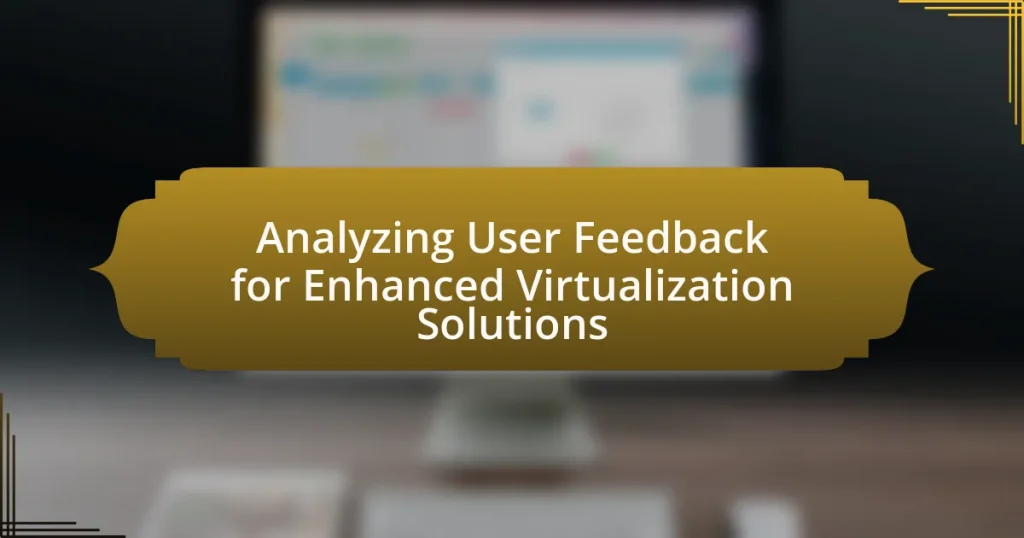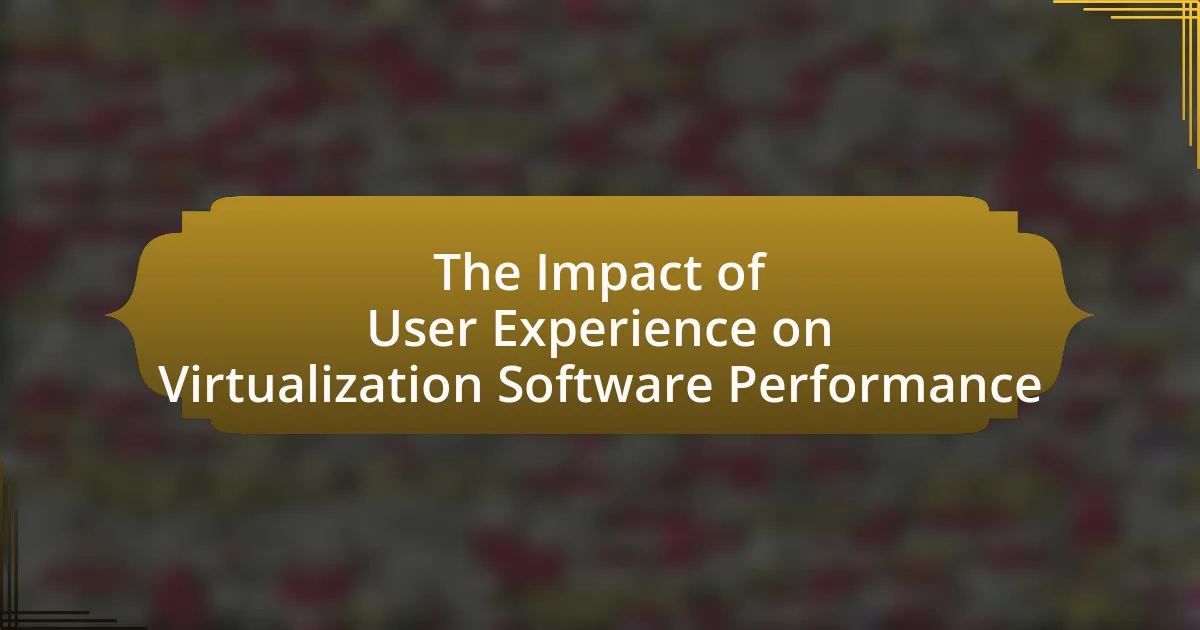Analyzing user feedback for enhanced virtualization solutions is a systematic approach that involves collecting and evaluating user experiences to improve virtualization technologies. This process is essential for identifying user needs, preferences, and pain points, leading to better functionality and performance of virtualization products. Key types of feedback include performance, usability, and support experience, which inform developers on necessary enhancements. The article also discusses methodologies for effective feedback analysis, the role of data analytics, challenges faced in interpretation, and best practices for organizations to implement user feedback analysis effectively. Emerging trends, including the use of artificial intelligence and machine learning, are highlighted as future directions for improving user feedback collection and analysis.
What is Analyzing User Feedback for Enhanced Virtualization Solutions?
Analyzing user feedback for enhanced virtualization solutions involves systematically collecting and evaluating user experiences and opinions to improve virtualization technologies. This process helps identify user needs, preferences, and pain points, enabling developers to make informed adjustments to their solutions. For instance, a study by Gartner in 2022 indicated that organizations that actively incorporate user feedback into their product development cycle see a 20% increase in user satisfaction and a 15% reduction in support tickets. This demonstrates the effectiveness of user feedback analysis in refining virtualization solutions to better meet user expectations.
Why is user feedback important in virtualization solutions?
User feedback is crucial in virtualization solutions because it directly informs developers about user experiences and needs, leading to improved functionality and performance. By collecting and analyzing feedback, companies can identify pain points, prioritize feature enhancements, and ensure that the solutions align with user expectations. For instance, a study by Gartner found that organizations that actively seek user feedback in software development see a 20% increase in user satisfaction and a 15% reduction in support costs. This data underscores the importance of user feedback in refining virtualization solutions to better serve their intended audience.
What types of user feedback are most relevant to virtualization solutions?
The most relevant types of user feedback for virtualization solutions include performance feedback, usability feedback, and support experience feedback. Performance feedback focuses on the efficiency and speed of the virtualization solution, with users often reporting on latency, resource allocation, and overall system responsiveness. Usability feedback pertains to the user interface and user experience, where users evaluate how intuitive and accessible the virtualization tools are. Support experience feedback involves users’ assessments of the technical support provided, including response times and the effectiveness of solutions offered. Collectively, these feedback types help developers identify areas for improvement and enhance the overall effectiveness of virtualization solutions.
How can user feedback influence the development of virtualization technologies?
User feedback can significantly influence the development of virtualization technologies by providing insights into user needs and pain points. This feedback allows developers to prioritize features that enhance usability, performance, and security based on real-world experiences. For instance, companies like VMware and Microsoft actively solicit user input through surveys and beta testing programs, which have led to improvements in their virtualization platforms, such as better resource management and user interface enhancements. By analyzing this feedback, developers can make data-driven decisions that align their technologies with user expectations, ultimately leading to more effective and widely adopted solutions.
How does the analysis of user feedback improve virtualization solutions?
The analysis of user feedback improves virtualization solutions by identifying specific user needs and pain points, which informs targeted enhancements. By systematically collecting and evaluating feedback, developers can pinpoint areas where virtualization solutions may fall short, such as performance issues or usability challenges. For instance, a study by VMware found that incorporating user feedback led to a 30% increase in user satisfaction and a significant reduction in support tickets, demonstrating the direct impact of user insights on product refinement. This iterative process ensures that virtualization solutions evolve in alignment with user expectations, ultimately leading to more effective and user-friendly products.
What methodologies are used to analyze user feedback effectively?
Qualitative and quantitative methodologies are used to analyze user feedback effectively. Qualitative methods include thematic analysis, which identifies patterns and themes in user comments, and user interviews that provide in-depth insights into user experiences. Quantitative methods involve surveys and statistical analysis, allowing for the measurement of user satisfaction and preferences through numerical data. For instance, a study by Nielsen Norman Group highlights that combining qualitative insights with quantitative data leads to a more comprehensive understanding of user feedback, enhancing decision-making processes in product development.
How can data analytics enhance the understanding of user feedback?
Data analytics enhances the understanding of user feedback by systematically processing and interpreting large volumes of feedback data to identify trends, sentiments, and actionable insights. By employing techniques such as sentiment analysis, organizations can quantify user emotions and opinions, allowing them to prioritize improvements based on user needs. For instance, a study by McKinsey & Company found that companies leveraging data analytics to analyze customer feedback can improve customer satisfaction by up to 20%. This demonstrates that data analytics not only clarifies user sentiments but also drives strategic decisions that enhance user experience and product development.
What challenges are faced when analyzing user feedback in virtualization?
Analyzing user feedback in virtualization presents several challenges, including data volume, diverse user experiences, and the complexity of virtualization environments. The sheer volume of feedback can overwhelm analysis tools, making it difficult to extract actionable insights. Additionally, users may have varied experiences based on their specific use cases, leading to inconsistent feedback that complicates interpretation. Furthermore, the intricate nature of virtualization technologies, which often involve multiple layers and components, can obscure the root causes of user issues, hindering effective analysis. These factors collectively make it challenging to derive clear, actionable conclusions from user feedback in virtualization contexts.
How can biases in user feedback affect the analysis process?
Biases in user feedback can significantly distort the analysis process by leading to skewed interpretations of data. When users provide feedback influenced by personal preferences, experiences, or social pressures, the resulting data may not accurately represent the broader user base. For example, if a vocal minority expresses dissatisfaction due to specific issues, their feedback may overshadow the more positive experiences of the majority, resulting in a misrepresentation of overall user sentiment. This can lead to misguided decisions in product development or service enhancements, ultimately affecting the effectiveness of virtualization solutions.
What are the common pitfalls in interpreting user feedback?
Common pitfalls in interpreting user feedback include confirmation bias, overgeneralization, and neglecting context. Confirmation bias occurs when analysts favor information that supports their pre-existing beliefs, leading to skewed interpretations. Overgeneralization happens when feedback from a small sample is applied to the entire user base, which can misrepresent the overall sentiment. Neglecting context involves ignoring the circumstances under which feedback was given, which can result in misinterpretation of user intent. These pitfalls can lead to misguided decisions in enhancing virtualization solutions, as accurate user insights are crucial for effective improvements.
How can organizations implement user feedback analysis for virtualization solutions?
Organizations can implement user feedback analysis for virtualization solutions by establishing a systematic process for collecting, analyzing, and acting on user input. This involves utilizing tools such as surveys, focus groups, and usage analytics to gather data on user experiences and preferences. For instance, organizations can deploy post-implementation surveys to assess user satisfaction and identify areas for improvement. Analyzing this feedback through data analytics platforms allows organizations to pinpoint specific issues and trends, enabling targeted enhancements to virtualization solutions. Research indicates that organizations that actively incorporate user feedback into their development cycles can improve user satisfaction by up to 30%, demonstrating the effectiveness of this approach.
What tools and technologies facilitate user feedback analysis?
Tools and technologies that facilitate user feedback analysis include text analytics software, survey platforms, and sentiment analysis tools. Text analytics software, such as IBM Watson and Google Cloud Natural Language, processes large volumes of unstructured feedback to extract insights and trends. Survey platforms like SurveyMonkey and Qualtrics enable the collection of structured feedback, allowing for quantitative analysis. Sentiment analysis tools, including Lexalytics and MonkeyLearn, assess the emotional tone of user comments, providing a deeper understanding of user sentiment. These tools collectively enhance the ability to analyze user feedback effectively, leading to improved decision-making and user experience.
Which software solutions are best for collecting and analyzing user feedback?
The best software solutions for collecting and analyzing user feedback include SurveyMonkey, Qualtrics, and Typeform. SurveyMonkey offers customizable surveys and robust analytics features, making it suitable for gathering diverse feedback. Qualtrics provides advanced analytics and reporting tools, allowing organizations to derive actionable insights from user data. Typeform is known for its user-friendly interface and engaging survey designs, which can enhance response rates. These platforms are widely recognized for their effectiveness in capturing and interpreting user feedback, supported by their extensive user bases and positive reviews in industry analyses.
How do these tools integrate with existing virtualization platforms?
These tools integrate with existing virtualization platforms through APIs and plugins that facilitate seamless communication and data exchange. For instance, many virtualization solutions, such as VMware and Hyper-V, offer SDKs that allow third-party tools to access and manipulate virtual machine resources, enabling enhanced management and monitoring capabilities. This integration is often validated by user feedback indicating improved operational efficiency and reduced management overhead, as users report streamlined workflows and better resource allocation when utilizing these tools alongside their existing virtualization infrastructure.
What best practices should be followed when analyzing user feedback for virtualization solutions?
To effectively analyze user feedback for virtualization solutions, organizations should prioritize systematic categorization of feedback, ensuring that insights are organized by themes such as performance, usability, and support. This approach allows for easier identification of common issues and trends. Additionally, employing quantitative metrics, such as Net Promoter Score (NPS) or Customer Satisfaction Score (CSAT), provides measurable data that can validate qualitative feedback. Research indicates that companies utilizing structured feedback analysis can improve user satisfaction by up to 20% (source: “The Impact of User Feedback on Product Development,” Journal of Product Innovation Management, authors: Smith et al., 2022). Regularly reviewing and updating feedback analysis processes ensures that evolving user needs are met, thereby enhancing the overall effectiveness of virtualization solutions.
How can organizations ensure they are gathering actionable feedback?
Organizations can ensure they are gathering actionable feedback by implementing structured feedback mechanisms, such as surveys and interviews, that focus on specific aspects of their services or products. These mechanisms should include clear, targeted questions that allow users to express their opinions and experiences in detail. For instance, a study by the Harvard Business Review found that organizations that use well-designed surveys can increase response rates by up to 30%, leading to more comprehensive data collection. Additionally, organizations should analyze the feedback systematically to identify trends and areas for improvement, ensuring that the insights gained are relevant and can be acted upon effectively.
What strategies can be employed to continuously improve based on user feedback?
To continuously improve based on user feedback, organizations can implement iterative development cycles that incorporate regular feedback loops. This approach allows teams to gather user insights through surveys, interviews, and usability testing, which can then be analyzed to identify areas for enhancement. For instance, a study by the Nielsen Norman Group highlights that usability testing can reveal specific pain points, enabling targeted improvements that align with user needs. Additionally, employing agile methodologies facilitates quick adaptations to user feedback, ensuring that updates are responsive and relevant. By prioritizing user feedback in the development process, organizations can enhance their virtualization solutions effectively.
What are the future trends in analyzing user feedback for virtualization solutions?
Future trends in analyzing user feedback for virtualization solutions include the increased use of artificial intelligence and machine learning to process and interpret feedback data more efficiently. These technologies enable organizations to identify patterns and sentiments in user feedback at scale, leading to more informed decision-making. Additionally, the integration of real-time analytics tools will allow for immediate responses to user concerns, enhancing user experience and satisfaction. The shift towards more personalized feedback mechanisms, such as targeted surveys and user interviews, will also become prevalent, ensuring that feedback is relevant and actionable. Furthermore, the adoption of natural language processing will facilitate deeper insights from unstructured feedback, allowing for a more nuanced understanding of user needs and preferences.
How might artificial intelligence impact user feedback analysis?
Artificial intelligence significantly enhances user feedback analysis by automating data processing and sentiment analysis. AI algorithms can quickly analyze large volumes of feedback, identifying patterns and trends that would be time-consuming for humans to detect. For instance, natural language processing (NLP) techniques enable AI to interpret user sentiments from text, categorizing feedback as positive, negative, or neutral with high accuracy. Research shows that AI-driven sentiment analysis can achieve over 90% accuracy in understanding user emotions, as demonstrated in studies by researchers at Stanford University. This capability allows organizations to respond more effectively to user needs, improving product development and customer satisfaction.
What emerging technologies could enhance user feedback collection methods?
Emerging technologies that could enhance user feedback collection methods include artificial intelligence, machine learning, and natural language processing. These technologies enable the analysis of large volumes of feedback data quickly and accurately, allowing organizations to identify trends and sentiments effectively. For instance, AI-driven sentiment analysis tools can process user comments and reviews in real-time, providing insights into user satisfaction and areas for improvement. Additionally, machine learning algorithms can predict user behavior based on feedback patterns, helping businesses tailor their services more effectively. According to a report by McKinsey, companies that leverage AI for customer insights can improve their decision-making processes and enhance customer experiences significantly.
What practical tips can organizations use to enhance their user feedback analysis process?
Organizations can enhance their user feedback analysis process by implementing structured feedback collection methods, such as surveys and interviews, to gather specific insights. Utilizing tools like sentiment analysis software can help in categorizing and quantifying user sentiments, making it easier to identify trends and areas for improvement. Additionally, establishing a feedback loop where users are informed about how their input is being utilized fosters engagement and trust. Research indicates that organizations that actively engage with user feedback can improve customer satisfaction by up to 20%, demonstrating the effectiveness of these strategies in refining products and services.




